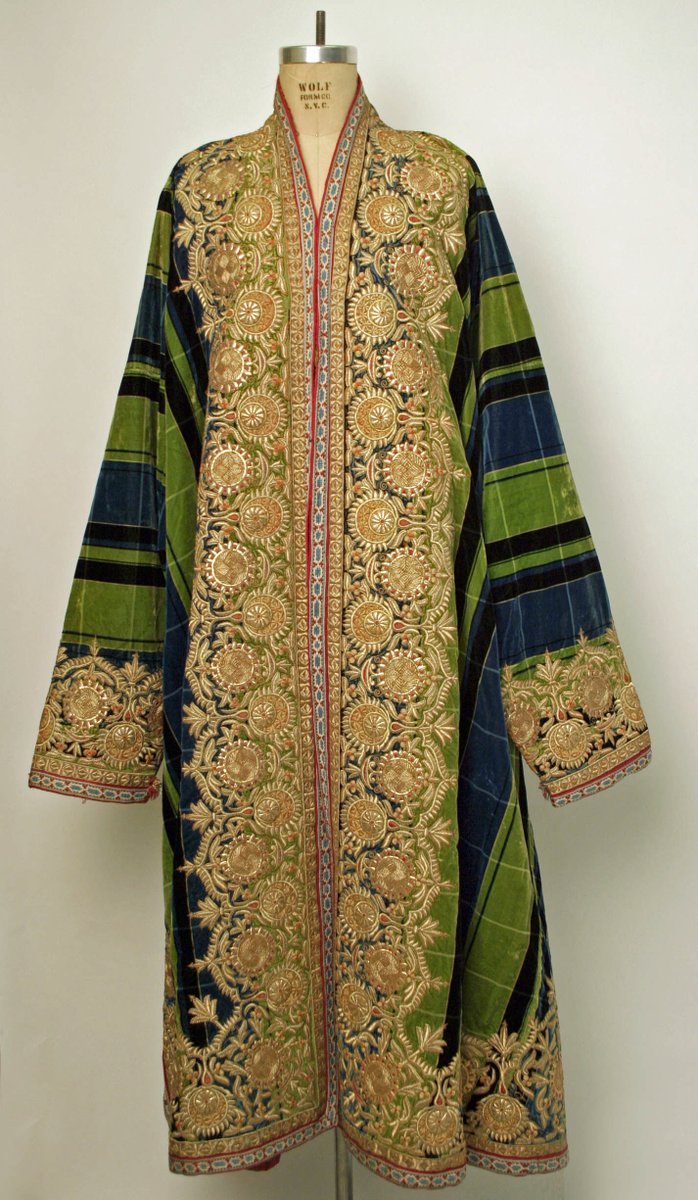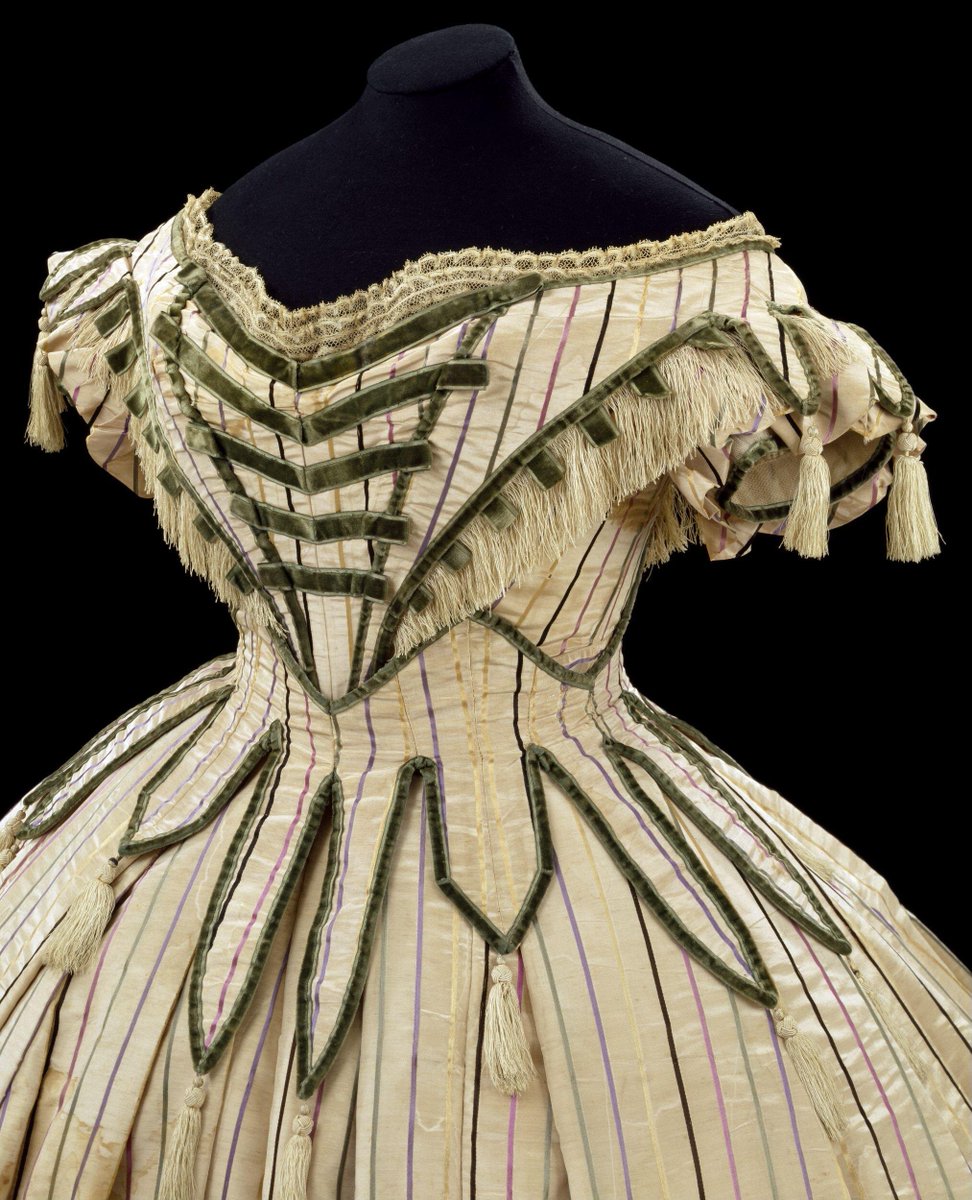
1 - Tonight's #threadtalk is a horse of a different color: green to be exact.
We'll talk emerald🟩, verdigris & olive🫒, too. Plus the connection between wallpaper, poison☠️ & privilege.
First: some color history back to our (literal) roots. (below, Redincote, 1786 - 1789)
We'll talk emerald🟩, verdigris & olive🫒, too. Plus the connection between wallpaper, poison☠️ & privilege.
First: some color history back to our (literal) roots. (below, Redincote, 1786 - 1789)
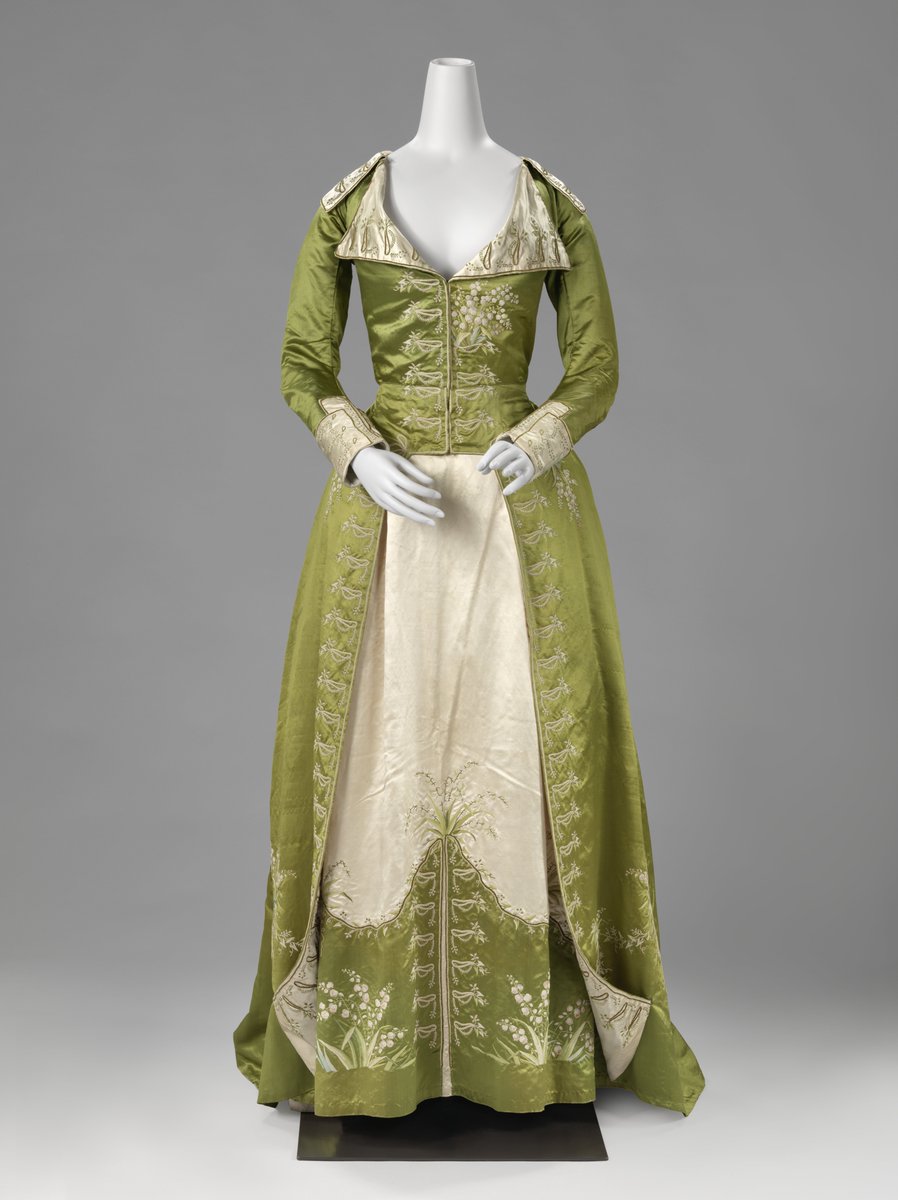
2 - If you peruse art history books, you'll notice: finding vibrant green dresses before the 18th century is quite a challenge.
And there is a reason for that: green it a notoriously difficult color to capture affordably & reliably.
Unless you're, you know...
And there is a reason for that: green it a notoriously difficult color to capture affordably & reliably.
Unless you're, you know...

3 - And even so, truly vibrant greens are even harder to find. This is for a number of reasons.
First & foremost, green dyes were often a combination of woad with other common dyes. Or natural dyes oxidized very easily. That meant fading, staining, and changing colors.
First & foremost, green dyes were often a combination of woad with other common dyes. Or natural dyes oxidized very easily. That meant fading, staining, and changing colors.

4 - For average folk, this was fine. We see lots of green homespun examples--Lincoln green, made of dyer's greenweed, or Genista tinctoria, gave rise to the iconic color of Robin Hood's Merry men.
But the king is NOT in green. Because fading? Staining? I think not, good sir.
But the king is NOT in green. Because fading? Staining? I think not, good sir.
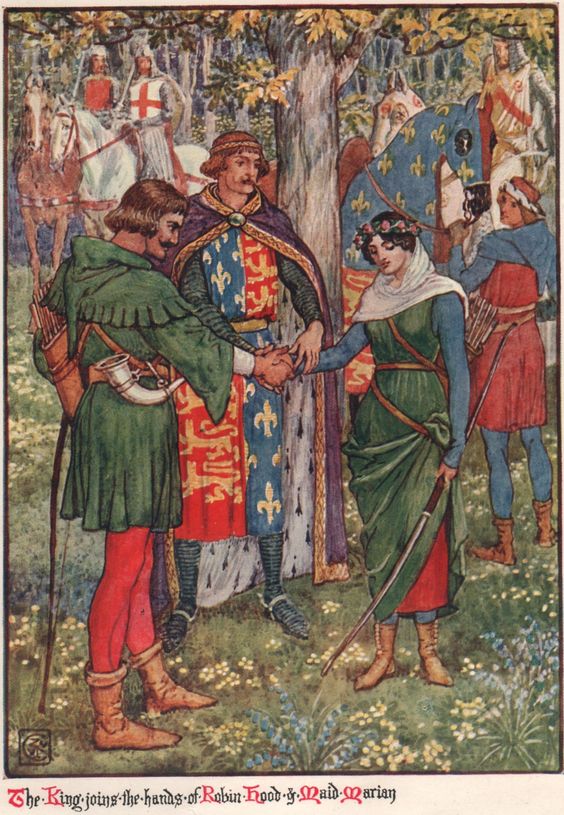
5 - Before I start skewering the rich though, I did learn that you can make an absolutely stunning forest green dye with MUSHROOMS 🍄. And I love mushrooms.
So you can take a little pause before we get to the nastier stuff and enjoy this wholesome moment:
So you can take a little pause before we get to the nastier stuff and enjoy this wholesome moment:
6 - Plants do make beautiful dyes. It's just that without mordants (the chemicals we created to hold dyes to cloth) they don't stay.
However, this incredible resource on Asian textiles is mind-blowing, & goes into detail on dozens of natural dye recipes. asiantextilestudies.com/green.html
However, this incredible resource on Asian textiles is mind-blowing, & goes into detail on dozens of natural dye recipes. asiantextilestudies.com/green.html

7 - Maybe that's why green stones, in particular, have always been so prized. This jadeite pendant features a seated lord, and would have been made by a Mayan artisan in the 7th or 8th century.
This green lingered, when all others faded. It must have seemed magical indeed.
This green lingered, when all others faded. It must have seemed magical indeed.

8 - This simple earring dates from Greece in the 3rd century BCE, but it's an emerald. Our eyes are drawn to it. We can't look away. Yes, the gold is lovely. But that pop of brightness? That springtime preserved?
That's power. That's magic, baby.
That's power. That's magic, baby.

9 - And here is a familiar face, for those of you who follow along: Shah Jahan, here contemplating an emerald. Wearing muslin. Draped in pearls and fine silks.
Shah Jahan was one of the Mughal lords, and a collector of precious jewels. But he, too, knew the lure of green.
Shah Jahan was one of the Mughal lords, and a collector of precious jewels. But he, too, knew the lure of green.

10 - By the early 18th century, mordants, like alum, come out on the scene. These are terribly caustic & require skilled hands (of workers). And there is a LOT of trial and error. And it's $$$$.
You also see verdigris show up. Which is the oxidation green you get from copper.
You also see verdigris show up. Which is the oxidation green you get from copper.

11 - Verdigris was also used earlier in some church vestments (which is a whole other topic I will cover at some point). There was a lot of back and forth about green and then purple and then red in priests robes.
But here's a chasuble with green velvet from 15th C Italy.
But here's a chasuble with green velvet from 15th C Italy.

12 - Anyway. We were talking about other caustic elements ruining society, weren't we?
This dress is one of my favorites of all time & it's made of Spitalfields damask silk that dates from the 1740s (designed by Anna Maria Garthwaite ), but sewn in 1775. It has matching shoes.
This dress is one of my favorites of all time & it's made of Spitalfields damask silk that dates from the 1740s (designed by Anna Maria Garthwaite ), but sewn in 1775. It has matching shoes.
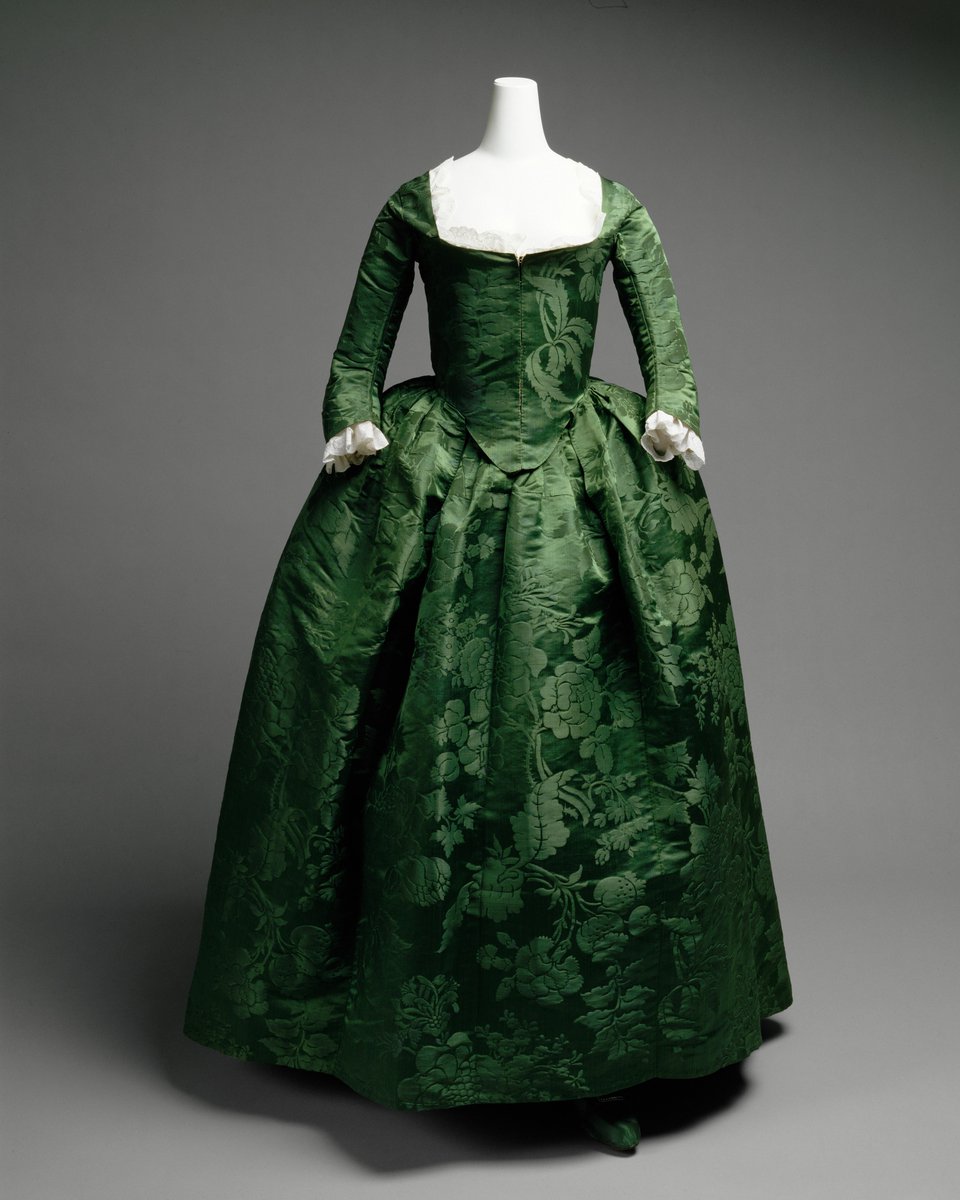
13 - Anna Maria Garthwaite was at the forefront of Spitalfields silk naturalist designs, but no one knows how she learned her craft. Because woman.
She worked in watercolors, and these were then rendered in silk by Huguenots who worked tirelessly to provide silks to the rich.
She worked in watercolors, and these were then rendered in silk by Huguenots who worked tirelessly to provide silks to the rich.

13 - The French Huguenots were escaping religious persecution & helped put Spitalfields silk on the map (they were also my ancestors--or those who didn't make it to Canada).
Anna Maria was also credited with this lovely *ladies* banyan. And y'all know I 💚 A BANYAN. My laws.
Anna Maria was also credited with this lovely *ladies* banyan. And y'all know I 💚 A BANYAN. My laws.

14 - But again, let's not pretend being a dyer was fun. Even before mordants, it meant working vats full of lye, urine, & combos of vegetation day in and out (like onions slurries).
Don't worry, though. We've got a new trend in town courtesy of Sweden's own Carl Wilhelm Scheele.
Don't worry, though. We've got a new trend in town courtesy of Sweden's own Carl Wilhelm Scheele.

15 - Scheele was a chemist & he helped discover oxygen. (Great pickup line.)
He pioneered research into tungsten, citric acid, lactic acid, hydrogen cynide & arsenic.
That last one is important. Apparently, it also makes a pretty pigment. Like this dress (c. 1860–1865).
He pioneered research into tungsten, citric acid, lactic acid, hydrogen cynide & arsenic.
That last one is important. Apparently, it also makes a pretty pigment. Like this dress (c. 1860–1865).

16 - The world went Gaga for Scheele's green. Soon followed by Paris Green, it cropped up everywhere. I mean everywhere.
Candies, flowers, children's toys. Yeah, they kind of knew arsenic wasn't great. But like, couldn't be that bad, right? Not when you look this good!
Candies, flowers, children's toys. Yeah, they kind of knew arsenic wasn't great. But like, couldn't be that bad, right? Not when you look this good!
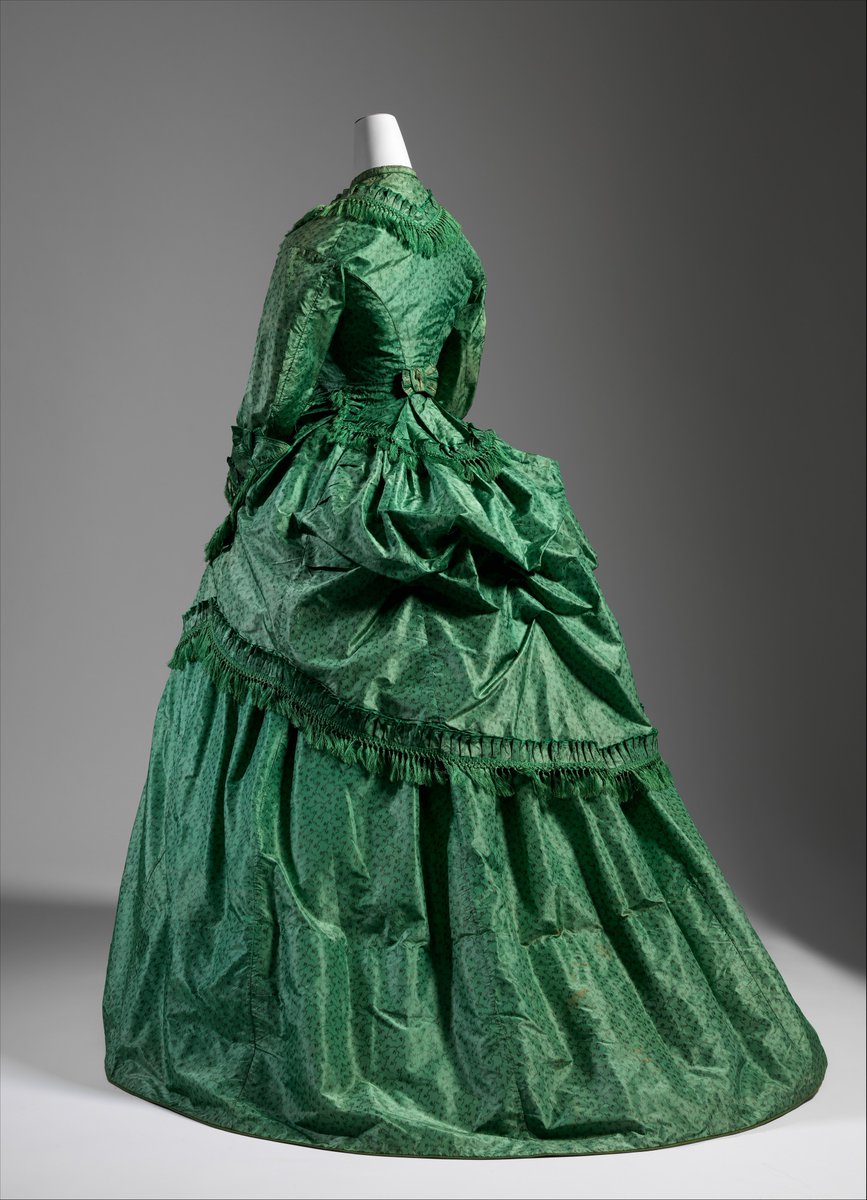
17 - Now, I primarily mean privileged white folk.
So many articles about poison dresses focus on the women wearing them.
The real tragedy is the workers--children, women, mostly--who died for decades before they did.
Mariah Pattie GETS it. Watch this.
So many articles about poison dresses focus on the women wearing them.
The real tragedy is the workers--children, women, mostly--who died for decades before they did.
Mariah Pattie GETS it. Watch this.
18 - Did women wearing these dresses fall ill? Probably. But their servants, seamstresses, tailors, dyers, staff & their families did *way* earlier.
When did it really become a problem? As Pattie points out: when Paris green made it to wallpaper and rich people started dying.
When did it really become a problem? As Pattie points out: when Paris green made it to wallpaper and rich people started dying.

19 - This is where we go wrong with fashion so often. We're lulled into a sense of comfort by the beauty. Even in this story, we think -- oh no! Pretty lady fainting in an eldritch dress!
But really? It's mothers dying of cancer & teens seeping green fluids from their mouths.
But really? It's mothers dying of cancer & teens seeping green fluids from their mouths.

20 - Rich white women were protected by layers & layers of their clothing & could afford to wear dresses only once or twice.
Same goes for this fellow and his snappy banyan. Remember: clothing is the ultimate luxury for most of human history.
Same goes for this fellow and his snappy banyan. Remember: clothing is the ultimate luxury for most of human history.

21 - And don't even get me started on radium. I mean, that's a whole other topic. Here's a video if you really want.
But I need to get going on dresses before I fall asleep. Must be all the poison!
But I need to get going on dresses before I fall asleep. Must be all the poison!
22 - You can literally see the colors shifting through the decades, so let's begin with Arnolfini! This caused quite a stir (not just because of all the squirrels) -- the cost of the dye alone (verdigris was probably involved) was shocking! Especially for a merchant couple. 
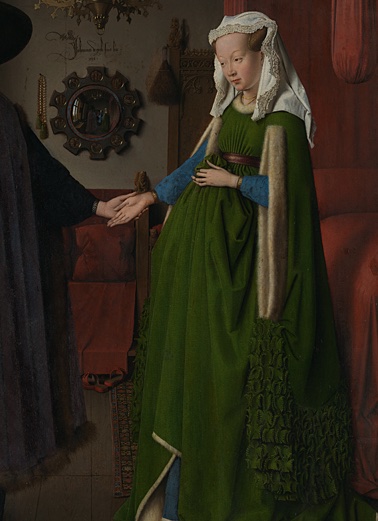
23 - Here we have an example from 16th C Italy with some damask gorgeousness. I am also about that trailing lacework. And her expression. 

24 - Coming into the early 19th century, I could not respect myself if I did not include more green velvet, let alone a velvet coat of such loveliness. It has some wear, but given the age it still has that glitter I love in garments like this. 10/10. Definitely Fae. 

25 - A nice compliment, I think, as a sort of broccoli and asparagus thing going on, is this spring green number, from around the same period. This green silk has some superb ruffling going on about the hem. I'm a sucker for ruffles. 1810-1815. 
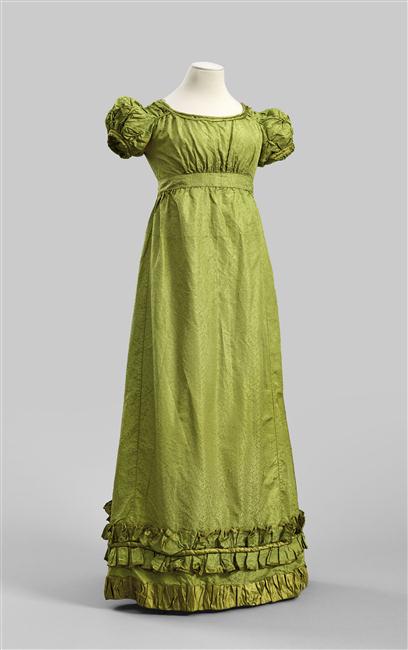
26 - This example from 1839 lists the color as "light gray green" and I believe it. Between fading and the available dyes, it actually makes sense. It's a wedding gown, but the tailoring is super modern.
Gotta love the leg-of-mutton sleeves.
Gotta love the leg-of-mutton sleeves.
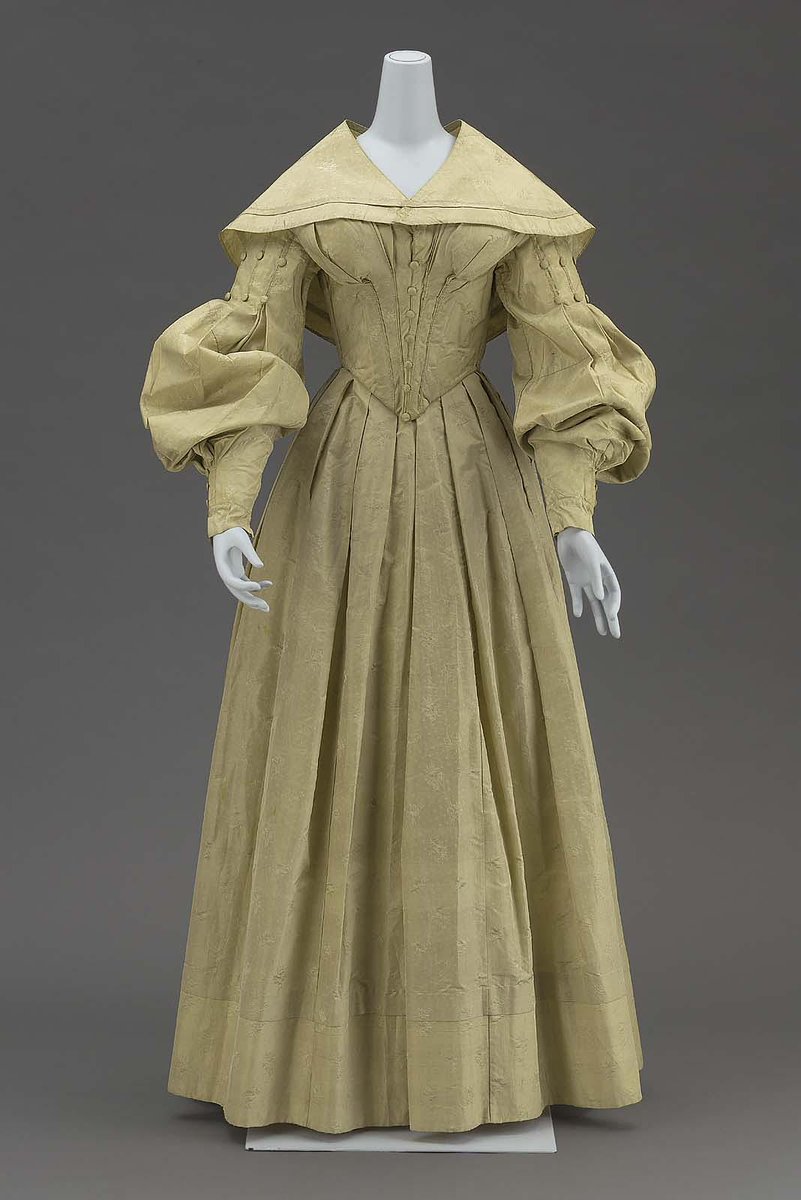
27 - A super early House of Worth/Boburgh green dress from 1869. But this one screams arsenic to me. Not sure about you. I just saw a pair of booties when I was doing my research, and they were this precise hue.
Imagine ironing this. With your bare hands. All those pleats.

Imagine ironing this. With your bare hands. All those pleats.


28 - This is taffeta, or changeable silk, and that means it catches the light just so. One of the reasons I love taffeta so much. Could be anywhere from the 1850s-1890s from the entry, but I'm guessing on the earlier side of that.
Still looks toxic, but has a lining so...?
Still looks toxic, but has a lining so...?

29 - Another vegetal gown with details galore -- this one may be too extra even for this insufferable Gemini. Is it the fringe that take it over the top for me? I just feel like this belongs in a circus rather than a ball. It's American (feels appropriate), from 1868. 

30 - And at last, but far from least: THE GREEN DRESS. FULL STOP.
I mean, I once wrote a love letter to it. It was owned by a countess. I'm not sure it's real, even. The way the light hits the fabric?
You can read the whole story here: vogue.com/article/counte…
I mean, I once wrote a love letter to it. It was owned by a countess. I'm not sure it's real, even. The way the light hits the fabric?
You can read the whole story here: vogue.com/article/counte…

31 - A few videos before the sources tonight! If you like watching dye vat videos like I do, check these out. First, all about Ph and color shifting:
32 - This whole series is delightful, but I love the idea of making dyes from reeds.
33 - Okay, on to our sources. Lots of good reading. Y'all, there is so much about green, I barely even got going tonight. I didn't even get to talk about the Statue of Liberty.
asiantextilestudies.com/green.html
mdhistory.org/the-dyes-of-de…
theconservationcenter.com/articles/2015/…
blog.fabrics-store.com/2021/03/21/nat…
asiantextilestudies.com/green.html
mdhistory.org/the-dyes-of-de…
theconservationcenter.com/articles/2015/…
blog.fabrics-store.com/2021/03/21/nat…
34 - More sources:
turncoatleather.com/color-verdigris
elizabethancostume.net/cibas/ciba1.ht…
postej-stew.dk/2019/05/mediev…
theparisreview.org/blog/2020/11/2…
georgianera.wordpress.com/tag/verdigris/
webexhibits.org/pigments/intro…
turncoatleather.com/color-verdigris
elizabethancostume.net/cibas/ciba1.ht…
postej-stew.dk/2019/05/mediev…
theparisreview.org/blog/2020/11/2…
georgianera.wordpress.com/tag/verdigris/
webexhibits.org/pigments/intro…
35 - And finally: en.wikipedia.org/wiki/Lincoln_g…
metmuseum.org/art/collection…
theguardian.com/books/2011/oct…
ateliernostalgia.wordpress.com/2015/03/12/a-t…
metmuseum.org/art/collection…
theguardian.com/books/2011/oct…
ateliernostalgia.wordpress.com/2015/03/12/a-t…
36 - So that concludes my first color-specific #threadtalk. Thanks for joining.
If you feel a little ill, just don't lick the wallpaper.
But seriously. It's okay to live in that weird place between ick & awe. It's what makes us human.
Question beauty. But notice it, too.
If you feel a little ill, just don't lick the wallpaper.
But seriously. It's okay to live in that weird place between ick & awe. It's what makes us human.
Question beauty. But notice it, too.

• • •
Missing some Tweet in this thread? You can try to
force a refresh






